

***Reminder: Slides are copyrighted and cannot be copied for publication.
A 4-year old boy was first seen in the clinic because of failure to thrive and vague symptoms like poor appetite and failure to gain weight. There was one other child in the family, a 7-year old sister who was in good health. The 4-year old was apparently fine for the first couple of years. He began to have diarrhea with light colored stools, however, this condition was not always present. Stool examinations were performed; however, they were reported as negative. Although the child was placed on a high protein, high calorie diet with vitamins and supplements, his improvement was limited.
Complete stool examinations were performed (O&P exam: direct wet mount, concentration, and permanent stained slide).
Laboratory results revealed the following:
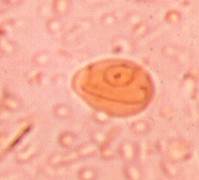
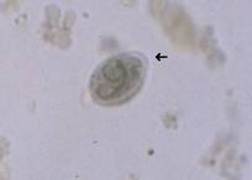
This is a wet preparation of stool; these organisms were seen using the high dry objective of the microscope. Motility was seen, but it was very limited and the organism identification could not be confirmed without completion of the O&P examination. This has been photographed at a high magnification.
(Scroll Down for Answers and Discussions)
ANSWER AND DISCUSSION OF DIAGNOSTIC QUIZ #66 (June, 2006)
The images presented in Diagnostic Quiz #66 are the following:
These images contain Chilomastix mesnili cysts; they measured approximately 5 by 7 microns. Although this organism was seen in the wet mount, additional morphology could be seen from the permanent stained slide examinations. This flagellate is considered nonpathogenic.
COMMEN ON THE ORGANISM:
Chilomastix mesnili tends to have a cosmopolitan distribution, although it is found more frequently in warm climates. C. mesnili has both trophozoite and cyst stages and is somewhat more easily identified than are some of the smaller flagellates such as Enteromonas hominis and Retortamonas intestinalis. The trophozoite is described as being pear shaped, measuring 6 to 24 µm in length and 4 to 8 µm in width. There is a single nucleus and a distinct oral groove or cytostome close to the nucleus. Flagella are difficult to see unless there is obvious motility in a wet preparation. The morphology can be confirmed by using a permanent stained smear, particularly when the cytostome is visible. The cysts are pear or lemon shaped, and they range from 6 to 10 µm in length and 4 to 6 µm in width. There is also a single nucleus in the cyst and the typical curved cytostomal fibril, which is called the shepherd's crook. Again, more definitive morphology can be seen on a permanent stain. C. mesnili normally lives in the cecal region of the large intestine, where the organisms feed on bacteria and debris. It is considered to be a nonpathogen, and no treatment is recommended. Since transmission is through ingestion of infective cysts, prevention depends on improved personal hygiene and upgraded sanitary conditions.
COMMENTS ON DIAGNOSIS:
Routine stool examinations are normally recommended for the recovery and identification of intestinal protozoa. However, in the case of C. mesnili, because the organisms are small, a series of several stools may be examined without recovering the organisms. Although cysts can often be identified on the wet stool preparation, many infections may be missed without the examination of a permanent stained smear.
TREATMENT:
Since C. mesnili is nonpathogenic, there would be no necessity for treatment. However, if the patient remains symptomatic, it would be important to do additional testing for other possible pathogenic parasites, as well as other causes. In this particular case, the patient's symptoms are probably related to some other cause OR a true parasitic pathogen may be present and has not yet been identified (Example: Giardia lamblia or Dientamoeba fragilis).
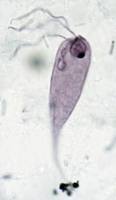 |
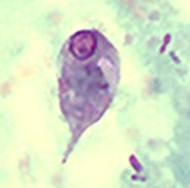 |
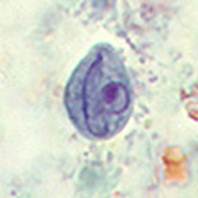 |
Three images of Chilomastix mesnili from positive stool specimens (from left to right: trophozoite seen in stained preparation (iron-hematoxylin); trichrome permanent stain showing trophozoite; trichrome stain showing cyst. Note the internal details (curved fibril) are somewhat difficult to see in the cyst, while the trophozoite morphology is more clearly seen on the permanent stained smear (oil immersion examination). Note the presence of the single nucleus and cytostomal groove in the trophozoite and the single nucleus and curved fibril (Shepherd's crook) in the cyst.
REFERENCES:
Garcia, LS, 2016. Diagnostic Medical Parasitology, 6th Ed., ASM Press, Washington, DC.
Garcia, L.S. 2009. Practical Guide to Diagnostic Parasitology, 2nd Ed., ASM Press, Washington, D.C.
Each Quiz has a two section format: the first section will present the Quiz topic and the second section will provide a discussion of the answer and/or various options in response to the Quiz situation presented to the user. In some situations, there may be more than one correct response.
The content within this site is made possible through the extensive contribution of Lynne S. Garcia, M.S., MT(ASCP), CLS(NCA), BLM(AAB), F(AAM), Director, Consultantation and Training Services (Diagnostic Medical Parasitology and Health Care Administration). For additional information, she can be contacted at LynneGarcia2@verizon.net.
Reference: Garcia, L.S. 2015. Diagnostic Medical Parasitology, 6th Ed., ASM Press, Washington, D.C.